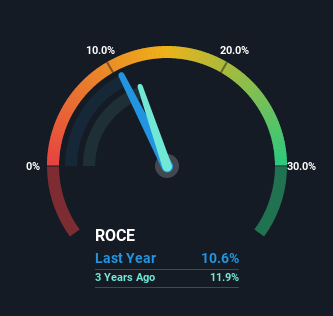Vp's (LON:VP.) Returns Have Hit A Wall
If we want to find a potential multi-bagger, often there are underlying trends that can provide clues. In a perfect world, we'd like to see a company investing more capital into its business and ideally the returns earned from that capital are also increasing. This shows us that it's a compounding machine, able to continually reinvest its earnings back into the business and generate higher returns. So, when we ran our eye over Vp's (LON:VP.) trend of ROCE, we liked what we saw.
What is Return On Capital Employed (ROCE)?
For those that aren't sure what ROCE is, it measures the amount of pre-tax profits a company can generate from the capital employed in its business. The formula for this calculation on Vp is:
Return on Capital Employed = Earnings Before Interest and Tax (EBIT) ÷ (Total Assets - Current Liabilities)
0.11 = UK£37m ÷ (UK£454m - UK£102m) (Based on the trailing twelve months to September 2021).
Thus, Vp has an ROCE of 11%. In isolation, that's a pretty standard return but against the Trade Distributors industry average of 14%, it's not as good.
Check out our latest analysis for Vp
Above you can see how the current ROCE for Vp compares to its prior returns on capital, but there's only so much you can tell from the past. If you're interested, you can view the analysts predictions in our free report on analyst forecasts for the company.
How Are Returns Trending?
The trend of ROCE doesn't stand out much, but returns on a whole are decent. The company has consistently earned 11% for the last five years, and the capital employed within the business has risen 44% in that time. 11% is a pretty standard return, and it provides some comfort knowing that Vp has consistently earned this amount. Stable returns in this ballpark can be unexciting, but if they can be maintained over the long run, they often provide nice rewards to shareholders.
The Bottom Line
In the end, Vp has proven its ability to adequately reinvest capital at good rates of return. However, over the last five years, the stock has only delivered a 28% return to shareholders who held over that period. So to determine if Vp is a multi-bagger going forward, we'd suggest digging deeper into the company's other fundamentals.
One more thing to note, we've identified 3 warning signs with Vp and understanding these should be part of your investment process.
While Vp may not currently earn the highest returns, we've compiled a list of companies that currently earn more than 25% return on equity. Check out this free list here.
Have feedback on this article? Concerned about the content? Get in touch with us directly. Alternatively, email editorial-team (at) simplywallst.com.
This article by Simply Wall St is general in nature. We provide commentary based on historical data and analyst forecasts only using an unbiased methodology and our articles are not intended to be financial advice. It does not constitute a recommendation to buy or sell any stock, and does not take account of your objectives, or your financial situation. We aim to bring you long-term focused analysis driven by fundamental data. Note that our analysis may not factor in the latest price-sensitive company announcements or qualitative material. Simply Wall St has no position in any stocks mentioned.


